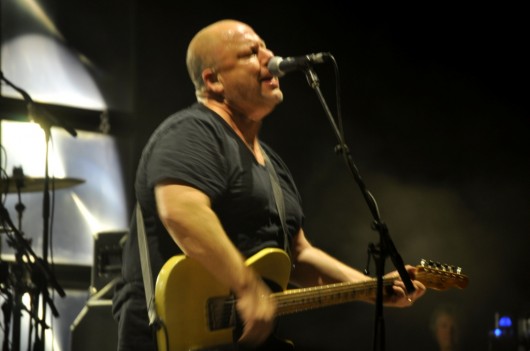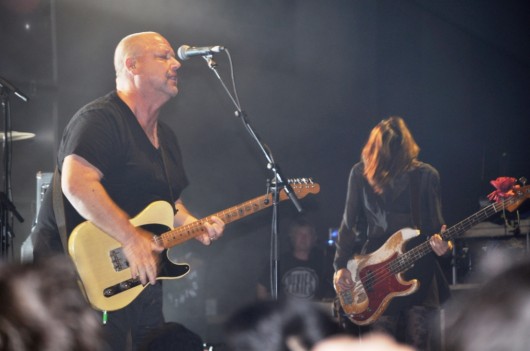Pixies review: Where Nirvana really came from
Posted on October 7, 2014 By Derek Owen entertainment, Entertainment, Front Slider, Music
 The strangest yet one of the most influential bands of the 1980s gave a few really good reasons why their music continues to attract sizable crowds – like the one Pixies drew Monday night at the Shaw Conference Centre.
The strangest yet one of the most influential bands of the 1980s gave a few really good reasons why their music continues to attract sizable crowds – like the one Pixies drew Monday night at the Shaw Conference Centre.
This young, urban group of bespectacled, plaid-clad hipsters weren’t going to be flicking their Bics in support of their heroes. No, that’s what jocks and headbangers would have done at a Def Leppard concert. Yet whatever their ages, fans of Pixies – the lost ‘80s heroes and unheralded progenitors of pretty much every form of popular rock music that came out the decade – still hold this treasured act pretty close to their hearts.
Fans were even willing to forgive a rough start. The band set a new land speed record for botched first song, with frontman Frank Black stopping the band erratically about 30 seconds into the show and starting over.
The band continued in a fairly off-kilter manner for the next few songs. With the exception of Caribou, it was one feedback-laden noise rock adventure after another, and not necessarily in an interesting way. They didn’t sound good, which is odd, as you’d think the generally uniformly bad sound at Shaw would encourage the noise rocker in all of them. Maybe it did.
 It was hard to say what the reason was, but thank God they settled down during jangly pop confection Monkey Gone To Heaven. The song was a sonic colonic for the rest of the night. The band hit their stride, moving more sensibly through their genre-busting catalogue, crossing each one off the list as they went along. Uptempo staccato torch song Hey featuring Black’s snarling vocals? Check. Psychobilly on crack on Nimrod’s Son with feedback solo in place of a fiddle? Check. The speed laden punk of Crackity Jones? Check.
It was hard to say what the reason was, but thank God they settled down during jangly pop confection Monkey Gone To Heaven. The song was a sonic colonic for the rest of the night. The band hit their stride, moving more sensibly through their genre-busting catalogue, crossing each one off the list as they went along. Uptempo staccato torch song Hey featuring Black’s snarling vocals? Check. Psychobilly on crack on Nimrod’s Son with feedback solo in place of a fiddle? Check. The speed laden punk of Crackity Jones? Check.
From songs like Debaser, Bone Machine, and River Euphrates, Black would do his patented Sam Kinison-style yelling while guitarist Joey Santiago would go off on his standard strange feedback-laced guitar runs, but the jewels of the band’s catalogue weren’t given a solid showing until Where Is My Mind? and Gouge Away, two songs with brooding, slightly eccentric, but instantly memorable bass-driven melodies, were dusted off. Kurt Cobain openly admitted he wanted to imitate the Pixies’ style, and concert attendees could hear for themselves in these songs where Nirvana really came from.
Pixies are so unique that it’s easy to see why they were a commercial flop in the ‘80s: they were completely out of step with everything else going on at that time. This is also why they became one of that decade’s most remarkable acts. Not designed for commercial success, at least not until the last few years of constant touring, it becomes clear in listening to their music that Pixies played a significant role in influencing many of the acts that became popular in the ‘90s, from Weezer to Filter to the Melvins to the numerous acts that came out of the Seattle grunge scene.
Opener and UK garage rockers Royal Blood showed fans that good music is good music even when it blurs genre lines. Given their almost Sabbath-esque love of the riff, as in the song Come On Over, the band sounded more metal, and seemed too talented to be deemed a garage or noise act. Made up of bassist Mike Kerr and energetic drummer Ben Fletcher, it’s hard to believe a two-piece can sound this heavy without an electric guitar. With their debut self titled album is already top 20 in Canada, Royal Blood will not be openers for long. UK rock rules once again.











